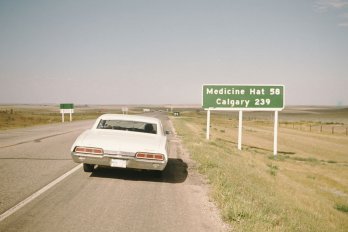No religious group in the world is more interested in your dead great-great uncle than the Church of Jesus Christ of Latter-day Saints. The Mormons started collecting genealogical material in the late nineteenth century, and in 1965 they built the Granite Mountain Records Vault just outside Salt Lake City. The 65,000-square-foot facility, carved into the side of its namesake mountain, houses billions of records, and every day Mormons around the world add to this increasingly high-tech repository.
A handful of those Mormons donate their time at the Provincial Archives of Saskatchewan, an arms-length government agency that oversees 29,000 linear metres of textual records, 1.8 million graphic and cartographic items, and 60,000 audio and video recordings. At its Regina research rooms, in a beige three-storey building shared with Elections Saskatchewan and a ScotiaMcLeod branch, you can find 1915 minutes from the Sinnett Rural Telephone Company, black and white photographs showing the aftermath of the 1946 Cupar cyclone, and a 1977 oral history of the Wahpeton Dakota Nation.
The push to future-proof more than 2 million items through digitization will take time and money, and there’s a lot of catching up to do. Less than 5 percent of the archive currently exists in the cloud. “I probably won’t be alive when we finish scanning the newspapers,” says archivist Donald Johnson. Whether at a relatively small provincial archive or the world’s largest library, the Library of Congress in Washington, digitization is typically done on a piecemeal basis: If a researcher requests a high-resolution scan of an obscure map, they pay for it themselves, sometimes hundreds of dollars. The institution then retains an electronic copy, which it makes available to future researchers. So when FamilySearch, the free search engine owned by the Mormons, offered to help speed up that process seven years ago, the Provincial Archives of Saskatchewan could hardly refuse. “Many hands make light work,” Johnson says. “And we have enough goals in common.”
On any given weekday, in a ground-floor room filled with numbered acid-free boxes, a forty-six-year-old man in black Crocs, blue khakis, and a bottle-green golf shirt passes document after document under a camera installed over his standing desk. A few feet away, two missionaries in their late sixties silently remove antique metal bindings and flatten worn edges in a digital-posterity assembly line. While their younger counterparts proselytize in the farthest corners of the earth, Rob Dilts and his silver-haired assistants enjoy a view of a parking lot as they make their way through fragile homestead records dating back to the 1890s.
Dilts, who is also the bishop of a local LDS ward, started working for FamilySearch eleven years ago, after three weeks of on-the-job training. Before coming to the archives, he digitized probate files at Saskatchewan’s Court of Queen’s Bench. Last year, he preserved more than 650,000 documents as grey-scale files. With every snap of his camera’s shutter, an image is previewed on an adjacent monitor and catalogued by proprietary software. At the end of each week, he sends an external drive to Utah, where its contents are audited, backed up to a server, and eventually posted online for the perusal of professional and amateur genealogists alike. FamilySearch then sends image files back to Regina by the terabyte, for the archives to keep.
It’s projects like this that have positioned FamilySearch as the world’s largest genealogical organization. A cursory scan of its website, familysearch.org, turns up century-old birth and death certificates from across Canada, sixteenth-century baptismal records from Croatia, and nineteenth-century marriage licences from the Philippines. Last year, the group partnered with archivists to capture what remains of Bosnia’s National Library. This past June, it announced plans to digitize the handwritten records of 4 million African American slaves. Byte by byte, FamilySearch is securing what many collections can’t on their own.
But while the public’s interest in archives is to preserve history, the LDS church also has an interest in altering it. Mormons are preoccupied with genealogy because they practise posthumous baptism: a living congregant is immersed in a walk-in baptismal font on behalf of a specifically named dead person. Because baptism is seen as a requirement for getting into heaven, this is akin to future-proofing the souls of ancestors who didn’t join the church. For non-believers, however, the practice can be deeply offensive. The church has been criticized for baptizing Mahatma Gandhi, Princess Diana, Elvis, Anne Frank, and even Pope John Paul II.
Despite the co-operation of strange bedfellows, much of Saskatchewan’s collection will likely never be converted to zeros and ones. Who knows how many small-town theatre playbills, grain invoices, and rural municipality maps will be of interest 500 years from now? That material may not become Googleable, but it will remain in deep, climate-controlled storage, unbothered by the constant digital migration that more in-demand documents will take on their voyage to the future. “We’re not only experts at remembering,” Johnson says. “We’re experts at forgetting.”
This appeared in the December 2015 issue.






